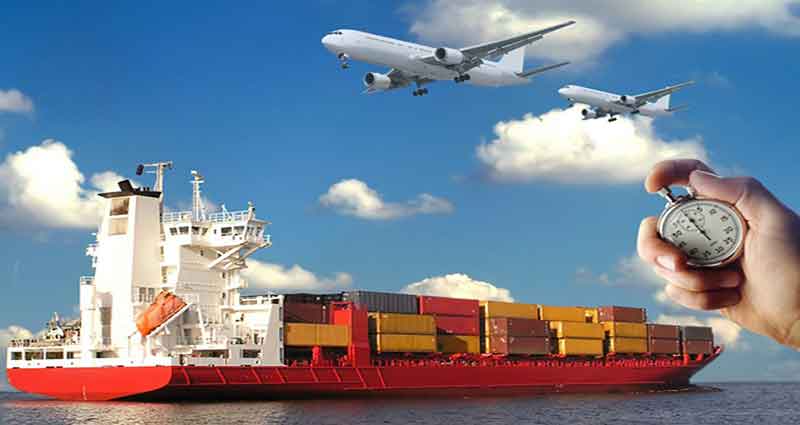Air and sea freight offer distinct advantages and challenges, depending on the cargo type, quantity, specific needs, etc. Today’s article will explore these differences to help you decide the best shipping method for your needs.
Types of cargo you can transport
Air freight is ideal when time is of the essence. It is particularly suitable for shipping items with limited shelf life, such as fresh foods, flowers, and pharmaceuticals.
On the other hand, sea freight is your go-to for bulky, heavy, or unusually shaped items. It is cost-effective for transporting large volumes and is less sensitive to weight and size limitations.
Moreover, sea shipping is also prime for goods not adversely affected by longer delivery times, such as machinery, raw materials, and non-perishable consumer goods.
Both air and sea freight can handle hazardous items, though air shipping typically faces stricter regulations. Restricted air cargo might include:
- Flammable items like perfumes
- Corrosive materials such as batteries
- Magnetic substances like speakers
It’s essential to consult with a freight forwarder to navigate these complex rules effectively before choosing air freight.
Sea freight vs air freight cost comparison
When comparing air vs sea freight costs, it’s crucial to understand how these are calculated. Freight forwarders typically determine shipping charges based on the greater of two measurements: volumetric or gross weight.
An air shipment is much more expensive than ocean freight of the same volume. This price difference is due to the limited capacity and higher operational costs associated with airplanes, including greater fuel consumption.
In contrast, ships can handle much larger cargo volumes at a lower price, making sea freight more economical than air.
To make you more clear, here’s an overview of shipping costs from China to the US:
| Air Freight | LCL Sea Freight | FCL Sea Freight | |
|---|---|---|---|
| 50kg | $350 | $695 | Not Advised |
| 150kg | $950 | $875 | Not Advised |
| 500KG | $2,700 | Not Advised | $1400 |
| 1500KG | $7,500 | $2850 | $3,250 |
Note: This price is only for reference.
As you can see, ocean freight emerges as the most cost-effective choice for shipments over 150kg. Conversely, for items weighing less than 150kg, choose air freight.
It’s important to note that freight rates can fluctuate dramatically. Booking in advance can secure a good shipping deal. For the most up-to-date and competitive rates, contact our shipping expert today!
Transit times for air and sea freight
There is no doubt that air freight is always faster than sea freight. When shipping by air, deliveries from China to global destinations usually take 2 to 7 days.
In contrast, ocean freight is notably slower, with transit times often spanning several weeks or months.
However, some forwarders offer express ocean services, such as Expedited LCL, which can sometimes be faster than FCL shipping.
These services come with guaranteed delivery days, presenting a quicker option for sea transport.
Here is a quick look at the estimated transit times for these different freight modes:| Air freight options | Delivery time | Sea freight options | Delivery time |
|---|---|---|---|
| Air Express | 3-5 biz days | Normal vessel | 30-45 days |
| Traditional air | 5-7 days | Speed vessel | 20-30 days (only to usa) |
Cargo volume capacities in air vs. sea freight
Ocean freight is unmatched in cargo capacity. To put it in perspective, a single 40-foot container can hold up to 10,000 beer bottles!
By contrast, air freight caters well to smaller, more delicate items that require faster delivery.
To further illustrate, let’s compare the unit load devices (ULDs) used in air freight with the containers used in ocean freight:
The common ULDs we work with include the following:
- LD-3 Container: 155 cubic feet, with a payload of 3,500 lbs.
- LD-6 Container: 314 cubic feet, with a payload of 7,000 lbs.
In comparison, ocean freight utilizes much larger containers:
- 20′ Standard Container: 1,172 cubic feet, with a payload of 52,000 lbs.
- 40′ Standard Container: 2,389 cubic feet, with a payload of 58,920 lbs.
As evident, a standard 20′ ocean freight container provides over seven times more space than an LD-3 air cargo container.
Given this, the clear recommendation is to opt for sea shipping when dealing with large or oversized shipments.
Ocean freight offers ample space and is more accommodating for such cargo, providing a more practical solution.

Cargo security: Which is safer, air or sea freight
Air freight typically holds the advantage over sea freight.
Air shipping is renowned for its heightened security measures compared to sea freight. With minimal handling involved in air cargo operations, the risk of damage to the shipment is significantly reduced, increasing the likelihood of safe delivery.
Additionally, airports adhere to stringent regulations governing the storage, handling, and securing of cargo, further enhancing the safety of air freight shipments.
Deciding between air freight and ocean freight
Typically, the number one reason for choosing air freight service is the speed of delivery. If you are under a tight deadline and your budget can accommodate the higher costs, transport via air.
Moreover, when handling the following shipments, choose air freight:
- Unitized Cargo: Items are easily organized on pallets or packaged individually, excluding loose bulk materials like sand or coal.
- High-value and lightweight products: Cargo such as jewelry, cosmetics, precision instruments, etc.
- Perishable goods: Fruits, vegetables, and processed meats demand quick delivery to preserve freshness.
Sea freight is a more flexible choice. It can accommodate a wider variety of goods due to fewer restrictions and simpler regulations.
Whether it’s bulk cargo, oil, heavy machinery, or unusual cargo like a horse, ocean freight is capable of meeting your needs.
Conclusion
Depending on your budget, cargo type, lead time, and specific shipping requirements, you should be able to find the most suitable methods for your company.
However, shipping isn’t always straightforward. Sometimes, a mix of air and sea freight may offer the best solution for your shipment.
At Airsupply, we provide flexibility and options tailored to your requirements. Whether you prioritize speed or cost efficiency, we offer a range of shipping routes and services to accommodate your needs.
Our competitive rates from various airlines and shipping lines ensure that you can select the most economical option for your air or sea freight shipments.
Furthermore, our expertise in customs clearance procedures ensures seamless compliance with regulatory requirements, facilitating the smooth passage of your goods through customs.




